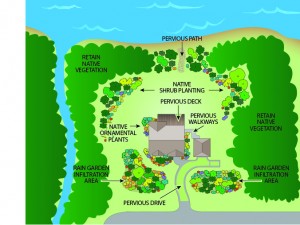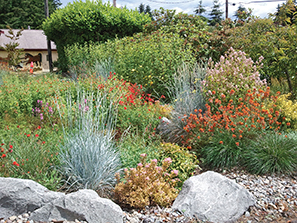 Nature can work for you! By working with nature you can cool your home, save energy, provide privacy, reduce your water bill, save time, avoid introducing invasive species and increase bird and wildlife activity. You can also prevent erosion and water runoff. Many Shore Stewards find that with careful site planning, nature can provide all of these things, inexpensively and attractively. By observing and understanding your property you can begin to design with nature, taking full advantage of the benefits it provides.
Nature can work for you! By working with nature you can cool your home, save energy, provide privacy, reduce your water bill, save time, avoid introducing invasive species and increase bird and wildlife activity. You can also prevent erosion and water runoff. Many Shore Stewards find that with careful site planning, nature can provide all of these things, inexpensively and attractively. By observing and understanding your property you can begin to design with nature, taking full advantage of the benefits it provides.
For example, if you keep trees like big leaf maple, vine maple and bitter cherry on the south side of your house, your home will be shady and cool in the summer. Dense existing vegetation can maintain your privacy and provide a screen from future development on neighboring properties. Dead trees or snags can be attractive and will provide homes for many birds such as woodpeckers, flickers, osprey, and bald eagles. Keep them if they are not a hazard. Carefully planning pathways to the beach can prevent erosion. Maintaining your views can be accomplished by carefully pruning limbs, instead of cutting down or topping a tree.
You might start by drawing a simple map of your property. Note where your home is and any paved surfaces, driveways and paths. Show the slopes, where water is and how it moves through your property, the soil conditions (clay, sand), and existing trees and shrubs and special views. Once you have your map you will start to see ways to work with nature. Observe your property over a few months to see the conditions in your yard. This will help you decide which plants would thrive on your property. Some plants do best in full sunshine, others prefer shade, and some work well anywhere. One plant might prefer dry locations, and another likes areas that remain moist. If you haven’t built your home yet and your land is not cleared, you have even more opportunities to work with nature.
 One of the best ways to get nature working for you is to simply keep existing soils and native plants, shrubs, and trees. If you retain what you have, you’ll save money, because buying replacement plants and trees can be expensive. You can reduce your water use, because established native plants are adapted to our dry summers. When you clear vegetation you open that area up to erosion and invasive weeds. For more on native plants see Guideline 3.
One of the best ways to get nature working for you is to simply keep existing soils and native plants, shrubs, and trees. If you retain what you have, you’ll save money, because buying replacement plants and trees can be expensive. You can reduce your water use, because established native plants are adapted to our dry summers. When you clear vegetation you open that area up to erosion and invasive weeds. For more on native plants see Guideline 3.
If you hire a contractor to do work on your land, make sure they understand your wishes regarding clearing. Mark the areas you want to protect. Walk the land with your contractor to agree on which trees should be protected. Heavy equipment damages tree roots and compacts soils. Compacted soils inhibit plant growth and leads to ponding of water because the pores in the soil are gone. Most trees will likely survive if at least 60% of the root system is unharmed. Keep ground disturbance at least as far out as the drip-line (outermost circumference of the tree canopy). Ask your contractor how the trees will be cleared. The quickest way is to scrape them away with a bulldozer, but using a chainsaw will protect the surrounding trees better.
Clearing on a bluff or slope has special considerations due to the hazards of landslides. If your property is located on a bluff, you may want shoreline access, whether by trail or stairwell. Sometimes it is easier and cheaper to share shoreline access with a neighbor, or use a community access nearby. If not, look for a natural trail to the shoreline along durable surfaces, or if you have room, design a trail that meanders, rather than going straight down to the beach.